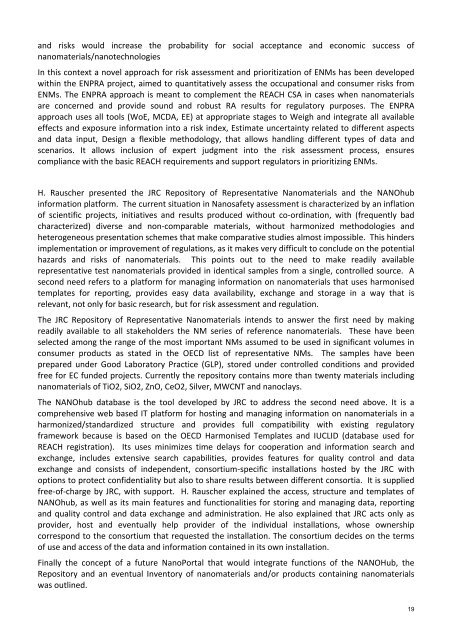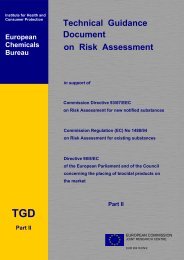Challenges of Regulation and Risk Assessment of Nanomaterials
Challenges of Regulation and Risk Assessment of Nanomaterials
Challenges of Regulation and Risk Assessment of Nanomaterials
You also want an ePaper? Increase the reach of your titles
YUMPU automatically turns print PDFs into web optimized ePapers that Google loves.
<strong>and</strong> risks would increase the probability for social acceptance <strong>and</strong> economic success <strong>of</strong><br />
nanomaterials/nanotechnologies<br />
In this context a novel approach for risk assessment <strong>and</strong> prioritization <strong>of</strong> ENMs has been developed<br />
within the ENPRA project, aimed to quantitatively assess the occupational <strong>and</strong> consumer risks from<br />
ENMs. The ENPRA approach is meant to complement the REACH CSA in cases when nanomaterials<br />
are concerned <strong>and</strong> provide sound <strong>and</strong> robust RA results for regulatory purposes. The ENPRA<br />
approach uses all tools (WoE, MCDA, EE) at appropriate stages to Weigh <strong>and</strong> integrate all available<br />
effects <strong>and</strong> exposure information into a risk index, Estimate uncertainty related to different aspects<br />
<strong>and</strong> data input, Design a flexible methodology, that allows h<strong>and</strong>ling different types <strong>of</strong> data <strong>and</strong><br />
scenarios. It allows inclusion <strong>of</strong> expert judgment into the risk assessment process, ensures<br />
compliance with the basic REACH requirements <strong>and</strong> support regulators in prioritizing ENMs.<br />
H. Rauscher presented the JRC Repository <strong>of</strong> Representative <strong>Nanomaterials</strong> <strong>and</strong> the NANOhub<br />
information platform. The current situation in Nanosafety assessment is characterized by an inflation<br />
<strong>of</strong> scientific projects, initiatives <strong>and</strong> results produced without co-ordination, with (frequently bad<br />
characterized) diverse <strong>and</strong> non-comparable materials, without harmonized methodologies <strong>and</strong><br />
heterogeneous presentation schemes that make comparative studies almost impossible. This hinders<br />
implementation or improvement <strong>of</strong> regulations, as it makes very difficult to conclude on the potential<br />
hazards <strong>and</strong> risks <strong>of</strong> nanomaterials. This points out to the need to make readily available<br />
representative test nanomaterials provided in identical samples from a single, controlled source. A<br />
second need refers to a platform for managing information on nanomaterials that uses harmonised<br />
templates for reporting, provides easy data availability, exchange <strong>and</strong> storage in a way that is<br />
relevant, not only for basic research, but for risk assessment <strong>and</strong> regulation.<br />
The JRC Repository <strong>of</strong> Representative <strong>Nanomaterials</strong> intends to answer the first need by making<br />
readily available to all stakeholders the NM series <strong>of</strong> reference nanomaterials. These have been<br />
selected among the range <strong>of</strong> the most important NMs assumed to be used in significant volumes in<br />
consumer products as stated in the OECD list <strong>of</strong> representative NMs. The samples have been<br />
prepared under Good Laboratory Practice (GLP), stored under controlled conditions <strong>and</strong> provided<br />
free for EC funded projects. Currently the repository contains more than twenty materials including<br />
nanomaterials <strong>of</strong> TiO2, SiO2, ZnO, CeO2, Silver, MWCNT <strong>and</strong> nanoclays.<br />
The NANOhub database is the tool developed by JRC to address the second need above. It is a<br />
comprehensive web based IT platform for hosting <strong>and</strong> managing information on nanomaterials in a<br />
harmonized/st<strong>and</strong>ardized structure <strong>and</strong> provides full compatibility with existing regulatory<br />
framework because is based on the OECD Harmonised Templates <strong>and</strong> IUCLID (database used for<br />
REACH registration). Its uses minimizes time delays for cooperation <strong>and</strong> information search <strong>and</strong><br />
exchange, includes extensive search capabilities, provides features for quality control <strong>and</strong> data<br />
exchange <strong>and</strong> consists <strong>of</strong> independent, consortium-specific installations hosted by the JRC with<br />
options to protect confidentiality but also to share results between different consortia. It is supplied<br />
free-<strong>of</strong>-charge by JRC, with support. H. Rauscher explained the access, structure <strong>and</strong> templates <strong>of</strong><br />
NANOhub, as well as its main features <strong>and</strong> functionalities for storing <strong>and</strong> managing data, reporting<br />
<strong>and</strong> quality control <strong>and</strong> data exchange <strong>and</strong> administration. He also explained that JRC acts only as<br />
provider, host <strong>and</strong> eventually help provider <strong>of</strong> the individual installations, whose ownership<br />
correspond to the consortium that requested the installation. The consortium decides on the terms<br />
<strong>of</strong> use <strong>and</strong> access <strong>of</strong> the data <strong>and</strong> information contained in its own installation.<br />
Finally the concept <strong>of</strong> a future NanoPortal that would integrate functions <strong>of</strong> the NANOHub, the<br />
Repository <strong>and</strong> an eventual Inventory <strong>of</strong> nanomaterials <strong>and</strong>/or products containing nanomaterials<br />
was outlined.<br />
19








